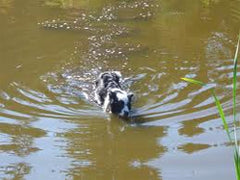
Pond Cleaning is very important for the overall health of your pond. Pond water needs to be clear for good production of fish. Clear ponds produce several times the amount of fish than turbid ponds. , after pond cleaning, clear ponds are much more fun to swim in! Most ponds become muddy after heavy rain, runoff, when ponds turn over or from excess decayed vegetation. Normally, silt or decay should settle out within one week’s time. Water clarity is normally 1 foot or more during most of the year. Fish production will be decreased in water with less than 1 foot visibility.
If pond water does not clear within a several days to a week’s time, the problem may be due to a combination of factors.
Turbidity is caused by clay particles suspended in the water that repel each other (colloidal clay) and will not settle out. Pond Cleaning for this problem can be done by adding material to the pond that causes these particles to clump and settle out.
Fish (such as bullheads and carp), along with crayfish, will cause water to be muddy due to their burrowing and feeding on the pond bottom. Remove these species and introduce predatory fish like largemouth bass or channel catfish. Ponds with a good population of predatory fish will not have crayfish problems and turbidity will be reduced.
Excessive weed growth decays and can become suspended. Heavy rain and runoff flush nutrients into the pond that weeds will thrive on. This weed an overabundance of decayed vegetation or “muck”. Wave movement or wind can cause this “muck” to turbidity throughout the pond. Reducing fertilizer applications near the pond, maintaining septic system, redirecting nutrient-rich runoff away from the pond will all reduce This reduction of nutrients in the pond will in turn reduce weed growth and decay.
3 good Pond Cleaning and turbidity control options are:
Gypsum (hydrated calcium sulfate) (available from fertilizer dealers) can clear colloidal clay problems. Scatter gypsum evenly over pond surface at the rate of 525 lbs. - .
Aluminum Sulfate (Clear-Pond) is a second option for clearing colloidal clay. An application of 50 lbs. week. Alum is best applied by dissolving in water and spraying over water surface.
If the pond is acidic (low pH) or soft water, add about 20 lbs. ) -
Beneficial Bacteria (AquaClear) is an option for pond muck removal. One gallon will treat 1 acre-foot of water. Best applied by mixing with 9 gallons of water. Normally, 4 weekly treatments will clarify the water and reduce the suspended solids.
http://kdwpt.state.ks.us/news/layout/set/print/fishing/special-fishing-programs.com
Please feel free to email me or post questions you may have regarding Pond Cleaning or any other pond topics and I will respond accordingly.
Next Steps:
To visit our online here
To Request our product catalog click here
To learn about lake weed analysis click here
_______________________________________________________
Pond Cleaning is very important for overall health of your pond. There are many things that you can do to ensure best possible care and maintenance for your pond, irrespective of any season, climate or weather conditions.
Tagged in: how to clean a pond, pond cleaning, how to clear muddy pond water, how to make a muddy pond clear, how to clear a muddy pond
